Yarrow / Spring / Summer / Autumn / Winter / Edible
Common Names
Arrowroot, bad man’s plaything, bloodwort, carpenter’s weed, death flower, devil’s nettle, eerie, field hops, gearwe, hundred leaved grass, knight’s milefoil, knyghten, milefolium, milfoil, millefoil, noble yarrow, nosebleed, old man’s mustard, old man’s pepper, sanguinary, seven year’s love, snake’s grass, soldier, soldier’s woundwort,
Botanical Name
Achillea millefolium
Scientific Classification
Kingdom – Plantae
Order –Asterales
Family – Asteraceae
Physical Characteristics for Yarrow
It has distinct feathery leaves and can remain hidden amongst long grass until you look closely. The leaves are alternate. The name ‘millefollium’ referring to its many leaves. It flowers from early summer to early autumn and has a composite flower head with 5 ray flowers and 10-30 disc flowers.
Leaves
Evenly distributed along the stem, with the leaves near the middle and bottom of the stem being the largest. The leaves have varying degrees of hairiness (pubescence). The leaves are 5–20 cm (2.0–7.9 in) long, bipinnate or tripinnate, almost feathery, and arranged spirally on the stems. The leaves are cauline, and more or less clasping.
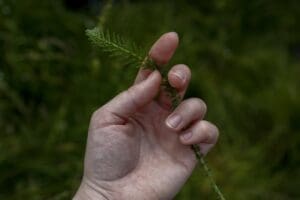
Flowers
Have 4 to 9 phyllaries and contains ray and disk flowers which are white to pink. The generally 3 to 8 ray flowers are ovate to round. Disk flowers range from 15 to 40. The inflorescence is produced in a flat-topped capitulum cluster and the inflorescences are visited by many insects, featuring a generalised pollination system.
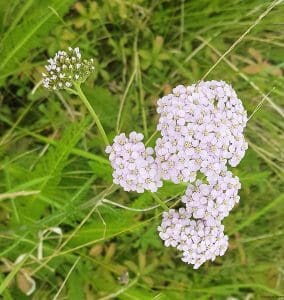
Fruits
The small achene-like fruits are called cypsela.
Habitat
Yarrow grows practically everywhere apart from Antarctica. It likes dry soils, meadows and clearings, often found along path-sides. Can grow from 1 to 3 feet tall.
Known Hazards
Yarrow has not been proved safe for use in pregnancy and lactation so caution is advised. Some people who are sensitive to the Aster family may have a mild allergic reaction. In rare cases, yarrow can cause severe allergic skin rashes; prolonged use can increase the skin’s photo-sensitivity. This can be triggered initially when wet skin comes into contact with cut grass and yarrow together.
According to the ASPCA, yarrow is toxic to dogs, cats, and horses, causing vomiting, diarrhoea, depression, anorexia, and hyper-salivation.
In a standard rodent model for reproductive toxicity, aqueous extracts of yarrow produced a significant increase in the percentage of abnormal sperm.
Could be Confused with
I have heard it said that you could confuse Yarrow with Wild Carrot, or Hemlock. However, I find that hard to believe. Learn to recognise the characteristics and you’ll be fine. For one thing, Wild Carrot (Daucus corota) does have vaguely similar leaves, but smells of carrot when crushed, and is edible anyway, and for another Hemlock (Conium maculatum) absolutely stinks and you’d be daft to put anything that smells like that in your mouth!
Edible Uses
Leaves – raw or cooked. A rather bitter flavour, they make an acceptable addition to mixed salads and are best used when young. The leaves are also used as a hop substitute for flavouring and as a preservative for beer etc. An aromatic tea is made from flowers and leaves. Essential oil from the flowering heads is used as a flavouring for soft drinks.
The leaves seem to be available most of the year-round, tender leaves appearing in early spring. It flowers from June to August and the seeds are usually available from July to September.
Notes on Herbal uses
Plant taste: Bitter, pungent, aromatic.
Plant energetics: Harmonising.
Parts used: Flowers, leaves, roots.
Plant properties: Astringent, relaxing diaphoretic, antiseptic, diuretic, anodyne.
Plant preparations: Tea, tincture, smudge, poultice.
Used for: Fevers, bleeding, wounds, infections, UTIs, fibroids, varicose veins, hemorrhoid’s.
Tea – Infuse 1 tsp (leaves and flowers can be used) in 8 ounces of water for 20-30 minutes. Drink 3-9 grams per day.
Tincture – Fresh leaves and flowers, 1:2 ratio, 95% alcohol. Take 2-5 ml per day. If using dried, use a 1:5 ratio with 40% alcohol. Same dosage.
Sitz bath – Dried whole plant. Use 4 ounces per gallon of water and infuse for 30 minutes, then add to sitz bathwater.
Poultice – Yarrow makes a great fresh plant poultice to stop bleeding, wounds and relieve bruising.
Extra notes from the Foragers
The English name yarrow comes from the Saxon (Old English) word gearwe, which is related to both the Dutch word gerw and the Old High German word garawa.
Hatfield Botanic Pharmacopeia speaking of Yarrow in 1886 – “it is indeed difficult to say in what complaints it may not with advantage receive employment. It is one of the common wayside herbs, and as useful and well adapted for recourse in almost any emergency where medicines are not at hand, as it is common.”
-
In the Hebrides, a leaf held against the eyes was believed to give second sight. [1]
-
In China, the stalks are dried and used as a randomizing agent in I Ching divination. [2]
-
In Greek folklore, Homer tells of the centaur Chiron, who conveyed herbal secrets to his human pupils, and taught Achilles to use yarrow on the battlegrounds of Troy. [3]
This herb is named after the great Greek hero named Achilles who fought in the battle of Troy.
Achilles was the son of the goddess Thetis and the mortal Peleus and was born a mortal. In an attempt to make her son immortal, Thetis dipped him into the River Styx. The only body part that remained mortal and vulnerable was his heel as his mother had held Achilles by one heel. Achilles grew up to be a famous hero and in the Battle of Troy Achilles used the herb Yarrow to heal his wounded soldiers. Achilles eventually was struck by an arrow on the only vulnerable spot on his body; his heel and he died.
-
In Egtved, Denmark they found a grave dating back to the Bronze Age. In the grave they found the remains of a woman about 20 years old. Buried along with the woman they discovered some jewelry and a yarrow plant. Yarrow followed the woman to protect her from evil spirits on her journey to the next world.
-
In many parts of Europe yarrow was believed to protect against all evil.
-
In Wales, the opposite was claimed. There it was told that bringing yarrow into the home was extremely unlucky. In some areas of Wales, it was even called “the death flower”.
-
In Ireland, yarrow was considered auspicious. Many used to hang yarrow around their house on midsummer night’s eve to protect the household from disease in the coming year.
-
In Scotland, it was also a lucky plant. In old superstition, they too claimed yarrow protected against malicious forces and used it as an amulet.



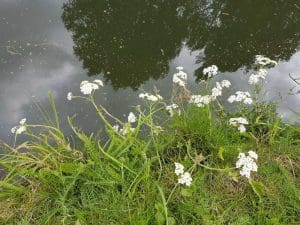
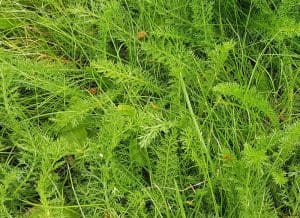
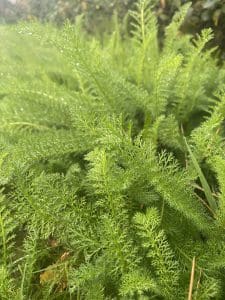
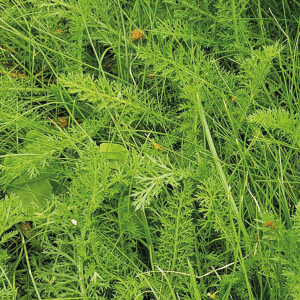



2 replies on “Yarrow (Achillea millefolium) Identification”